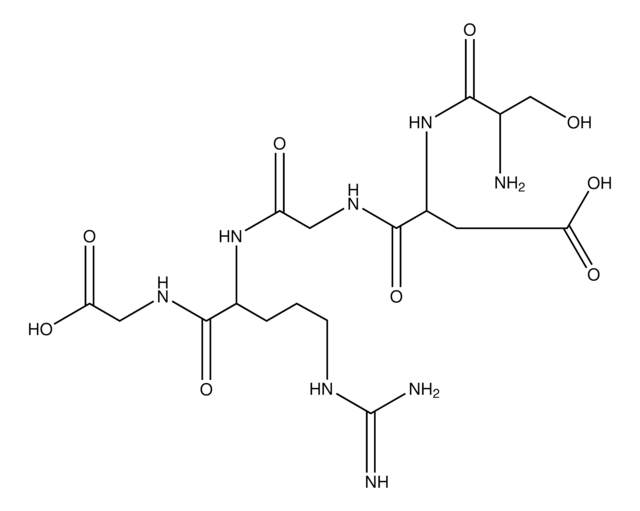G1269
Gly-Arg-Gly-Asp-Ser-Pro-Lys
≥97% (HPLC)
Synonyme(s) :
GRGDSPK
About This Item
Source biologique
human
Niveau de qualité
Pureté
≥97% (HPLC)
Forme
powder
Technique(s)
blocking: suitable
ligand binding assay: suitable
Température de stockage
−20°C
Chaîne SMILES
NCCCC[C@H](NC(=O)[C@@H]1CCCN1C(=O)[C@H](CO)NC(=O)[C@H](CC(O)=O)NC(=O)CNC(=O)[C@H](CCCNC(N)=N)NC(=O)CN)C(O)=O
InChI
1S/C28H49N11O11/c29-8-2-1-5-16(27(49)50)37-25(47)19-7-4-10-39(19)26(48)18(14-40)38-24(46)17(11-22(43)44)36-21(42)13-34-23(45)15(35-20(41)12-30)6-3-9-33-28(31)32/h15-19,40H,1-14,29-30H2,(H,34,45)(H,35,41)(H,36,42)(H,37,47)(H,38,46)(H,43,44)(H,49,50)(H4,31,32,33)/t15-,16-,17-,18-,19-/m0/s1
Clé InChI
ZRVZOBGMZWVJOS-VMXHOPILSA-N
Informations sur le gène
human ... ITGA2B(3674) , ITGAV(3685)
Vous recherchez des produits similaires ? Visite Guide de comparaison des produits
Amino Acid Sequence
Description générale
Application
- as a blocking peptide to inhibit integrin-fibronectin binding
- in adhesion assay performed on porcine trophectoderm to study the influence of TGFβ (transforming growth factor) on cell adhesion
- for incubation of MC3T3-E1 osteoblast cells to determine its effect on cell adhesion measured by AFM (atomic force microscopy)
- for the preparation of RGD.Flt23k.NR nanoparticles
- to determine the involvement of RGD-integrin bonding in cell adhesion process
Actions biochimiques/physiologiques
Code de la classe de stockage
11 - Combustible Solids
Classe de danger pour l'eau (WGK)
WGK 3
Point d'éclair (°F)
Not applicable
Point d'éclair (°C)
Not applicable
Équipement de protection individuelle
Eyeshields, Gloves, type N95 (US)
Certificats d'analyse (COA)
Recherchez un Certificats d'analyse (COA) en saisissant le numéro de lot du produit. Les numéros de lot figurent sur l'étiquette du produit après les mots "Lot" ou "Batch".
Déjà en possession de ce produit ?
Retrouvez la documentation relative aux produits que vous avez récemment achetés dans la Bibliothèque de documents.
Les clients ont également consulté
Notre équipe de scientifiques dispose d'une expérience dans tous les secteurs de la recherche, notamment en sciences de la vie, science des matériaux, synthèse chimique, chromatographie, analyse et dans de nombreux autres domaines..
Contacter notre Service technique



